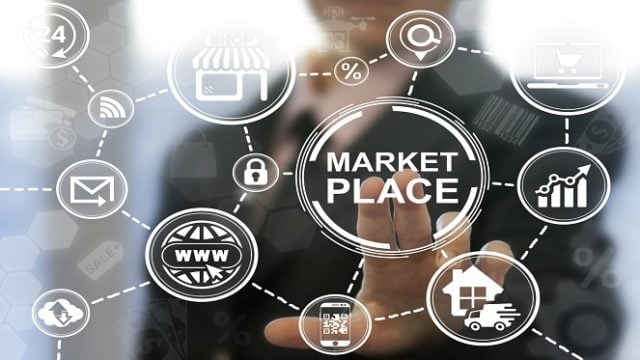
Convenient online shopping has disrupted the retail sector which has been operating on the same principles for decades, even centuries, in multiple ways. Prior to the massive human migration to the online marketplace, the size and look of your business premises and the poshness of your address were a major part of your value and market positioning. People were willing to buy at exorbitant prices simply because they bought the item at an exclusive store in a high-end shopping district or mall. On the internet, these things don't matter anymore. People look for products, brand-name products for sure, and there definitely are preferences among online shoppers for certain online stores, but apart from that, all they really care about is the price. Who the vendor is doesn't really matter. Online commerce has therefore levelled the playing field for small enterprises to compete with big businesses based on the product range they can supply, and—because they have fewer overheads—are paradoxically able to supply a product at a lower price than the big, well-known suppliers can, giving them a comparative advantage. The internet has in fact become, the ultimate free-market system.

Gone are the days when you have to choose between two or three options that are available in your area—you can now find the item you're looking for in the widest possible variety of colours, styles, brands, sizes, and places. You don't need to settle for that blouse in grey at your local department store if you can order it in the colour you actually wanted from an online store based in New York, or anywhere else on the globe for that matter, and possibly even at a better price. No more "chocolate or vanilla"—spend significant mental energy in choosing the exact flavour you want!
Convenient Online Shopping Takes the Legwork out of Browsing
Convenient Online Shopping Let's You Compare Prices Easily
No More Queues or Parking Meters
Inbound Marketing: Attract, Engage, and Delight Your Clients
The Keys to Commercial Success in Online Retail
Looking for a new outfit for your cousin's wedding, but not quite sure what you want? Searching for the perfect birthday gift for your best friend, but can't find it locally? Have the perfect outfit for that party but the right shoes to go with it eludes you? Do what almost everyone is doing: Hop on the internet and search for the item you want. A list of stockists and sellers of what you need will appear, where you can not only browse until you find the item that is exactly right but compare the prices of different online stores to make sure you get the best buy. Order and pay for it through several different payment options, and wait for it to be delivered. Simple, right?
For many people, dawdling around and window shopping in a mall or shopping district is a fun thing to do, especially if you're not looking for anything in particular and just want to make it a day outing. For many others, however, going shopping is the last thing they want to do: Getting in the car and finding parking, walking for what seems like miles to the relevant shops, jostling with other people in shops and walkways, standing in queues, and then carrying a load of packages, boxes, and bags to wherever you thought you parked your car and then paying for the parking as well. There are many better ways to spend your precious, peaceful Saturday afternoons. In the U.S. alone, the growth of people opting to shop online has risen by more than 35% over the past three years, 46% of consumers indicate that they shop only online and never go to a physical retail shop, while 83% of shoppers cite convenience as the main reason for opting to buy online.
Walking from shop to shop, looking for something you don't know you really want or need is a pain in the neck for most. Isn't it just better to let the shop come to you, display the range they have in stock for the item you're looking for, give you access to the opinions of others who bought the product through customer reviews, and give you the ability to see if you can find the same thing elsewhere at a better price? The answer is a resounding yes. Browse product categories if you're uncertain of what you're looking for, zone in on the ranges available for particular items, and decide what you want without so much as having to get dressed and walk 200 meters.

The internet is awash with online stores that sell anything and everything in one place or specialises in particular niche products. Compare not only prices, but styles, colours, fabrics, and sizes at your convenience. Take delivery costs into account when considering the price, get a sense of the quality from the reviews of other buyers, and then select the item you desire at the lowest cost, without walking from shop to shop or driving from mall to mall.
The wealth of information available online can help you find the right tool or product for a particular job, and can probably let you view a YouTube video on how to install or fix something. If you prefer a certain brand, you will find it for sale online, if you don't have a particular preference, you can view a multitude of products from different makers. Globally, more than 83% of consumers indicate that they research a product online before making a decision to buy, while 59% interacted in online engagement forums, such as chats or contact forms to ask questions and get answers before they buy.
Shop all you need to shop without waiting in line to pay or having to pay for parking. Simply select, pay via your debit, credit card, PayPal, Payoneer, or any number of other payment options, supply your address, and get up from your desk to go make a cup of coffee knowing your order is on its way to your door. Apart from ditching the drive, you don't even need a computer to shop anymore: 51% of consumers ordered and paid for goods online using their smartphones, with a large proportion of these shoppers buying from a different retailer than the one they originally intended to buy from because of the appeal of different landing pages.

Gone are the days where a particular store can fob you off with a simple "we're out of stock" or "we only sell it in this size/colour/fabric". Gone are the days when your choices are vanilla, chocolate, or strawberry ice cream—take it or leave it.
This shift in the range of choices available through convenient online shopping has disrupted the business of marketing in multiple ways. Marketers no longer focus on in-your-face advertising, shoving information you don't want or need down your throat, or aggressively manipulating your emotions in order to make a sale. With convenient online shopping, you have the ability to search online for information on the products or services you are interested in, to find as much information on them as possible, allowing you to make an informed choice in what has become known as "inbound" marketing.
Inbound marketing strategies evolved because retailers and manufacturers increasingly realised that intrusive marketing strategies such as telesales, huge visuals with provocative images, and essentially informing a potential customer that they need that product, and need it now, are just not how people prefer to be approached.
When it comes to parting with your hard-earned cash, you want to take your time to investigate your options, gather information about the pros and cons of certain products, get the opinion of others who have purchased these products, and an informative description that answers the questions you may have about why the product would add value to your day-to-day life—in short, not simply a product description that gives you dimensions and features, but rather a well-informed explanation of the difference the product can make in your life. Not just the product itself, but the function and need it would fulfil.
Traditional outbound marketing strategies focus on attracting potential clients, while inbound strategies focus on the provision of information and the answering of questions (engagement), as well as building relationships by providing service and quality that will make the client come back again and again, leaving the "attracting" of their clients to the quality of information on their websites, and essentially, to the word of mouth spread about the excellence of their products, services, and consistency. In other words, businesses that use inbound strategies stay in business because they are unintrusive, knowledgeable, and provide excellent service—it's not about moving stock anymore, it's about providing a superior shopping/buying experience to the client, and not just a product in a branded bag they can carry out of the store!
These facts are borne out by the statistics. More than 65% of consumers indicate that they will purposefully avoid a particular retailer after just one bad experience with them, while almost 90% would cross that supplier off their lists completely after more than one bad experience.
As explained in this post, the power dynamics between buyers and sellers have been completely upended by the internet. Consequentially, the marketing strategies used to attract, engage, and retain (or delight) consumers needed a complete overhaul in terms of understanding the psychology that drives consumer behaviour in a digital landscape. Creative shop window displays, huge provocative imagery, and aggressive in-your-face sales tactics just don't cut it anymore.
The keys to being commercially successful in the e-commerce business environment of today are to create content so informative that it will rank highly on search engines, in what is called Search Engine Optimisation (SEOs), as more than a quarter of shoppers click on the first search result that appears on their screen.
Secondly, professionally designed landing pages that visually communicate what your business is about and what it is that you sell. Simplicity in navigation, clear links to product ranges, additional information about company values that you know will appeal to your target market (such as sustainability, links with charities, your production processes, the materials you use and how you source them, and so forth), and simplified categorisation of your product ranges that make sense—an online shopper is likely to be shopping online to save time and don't have a mind to go searching in a broad category of "men's shirts" for a 100% cotton informal men's gym shirt. Study your own inventory and develop a system of arranging and presenting your products that make them easy to find by using keywords or phrases to use in your product descriptions—to be picked up by search engines—and a search function on your site itself.
Thirdly, streamline the selection and payment process to be as simple as possible. Place an artful and stylish picture of a particular product with a link to "add to cart" right there next to it, and consider making it possible to insert a link that will allow your potential buyer to view similar products in that category as well as reviews from other buyers.
In the fourth instance, make an effort to provide as many payment options as possible for clients ready to "checkout". Credit or debit card, direct electronic funds transfers, PayPal, Payoneer, cash on delivery...in short, make the journey from the cash in their hands to your cash register or bank account as easy as possible! Invest in finding a courier or delivery service that is quick, friendly, and organised to the max. There is no room for delivering the wrong orders to the wrong clients, deliveries that take weeks and weeks to reach their destinations, and a delivery service incapable of keeping track of what they deliver, to who, where, and when.
All of these things reinforce, over and over again, that buying from your business is pleasant, easy, convenient, and reliable and that you as a business are willing to go the extra mile by providing quality and topical information, communicating regularly and with a "soft-touch", providing multiple ways for clients to contact you, responding to client questions and needs in a flash, and doing so with professional and respectful communication that makes your client feel that their needs are a priority to you and your business.

© Copyright 2024 Tarsus Distribution